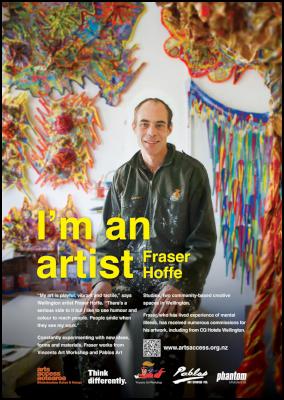I’m an Artist Campaign to change attitudes
I’m an Artist Campaign to change attitudes

Fraser Hoffe of
Wellington is one of five artists to be featured in a
national campaign aimed at changing attitudes and behaviour
towards people with disabilities, sensory impairment and
mental ill-health. The campaign will be launched in five
cities over five weeks, starting in Wellington on Monday 6
October to coincide with Mental Health Awareness
Week.
Fraser, whose artwork will be on display from 6 to 13 October in CQ Hotels Wellington, has lived experience of mental ill-health. He describes his art as “playful, vibrant and tactile”.
The I’m an Artist Campaign will showcase Fraser and four other artists on huge posters, to be pasted up on streets in Wellington, Auckland, Hamilton, Christchurch and Dunedin.
Arts Access Aotearoa is organising this social change campaign with funding from the Ministry of Social Development’s Making a Difference Fund. The campaign promotes disabled people and people with lived experience of mental ill-health as artists who make great art, often with the support and guidance of community-based creative spaces.
For Fraser, attending Vincents Art Workshop has been life-changing. “Before Vincents, I was homeless for about 15 years … living in boarding houses and moving around a lot. Vincents gave me a place to come to every day, and it focused my energy on being creative and making art.”
Fraser goes to Vincents Art Workshop every week day except Thursday (a women’s-only day at Vincents), when he goes to Pablos Art Studios.
Richard Benge, Executive Director, Arts Access Aotearoa said: “There are many terrific artists in New Zealand who just happen to have a disability. This campaign focuses on five. Fortunately, they get support and motivation from innovative creative spaces such as Vincents and Pablos.
“However, these creative spaces are vulnerable to lack of funding and policy changes. Central and local government, health and welfare agencies, and the private sector all have a role to play in ensuring their sustainability.”
Statistics New Zealand figures show that in 2013 one in four (24 % or 1.1 million people) of New Zealanders was identified as having a disability.
“With an ageing population, this number will continue to grow,” Richard said. “Opportunities for creative expression and attendance at live performances and art galleries need to be accessible for everyone.”
The five artists and their creative spaces featured on the posters
• Allyson
Hamblett, a visual artist and media assistant at Spark
Centre of Creative Development, St Lukes, Auckland, has
cerebral palsy.
•
• Kamini Nair, a visual artist
at Sandz Studio and Gallery in Hamilton, has an intellectual
disability.
•
• Michael Krammer, a dancer and
tutor with Jolt Dance in Christchurch, has
autism.
•
• Tanya Faiva, a visual artist at
Studio2 in Dunedin, has a physical
disability.
•
• Fraser Hoffe, a visual artist at
Vincent’s Art Workshop and Pablos Art Studios in
Wellington, has lived experience of mental
ill-health.
Arts Access Aotearoa advocates for people in New Zealand who experience barriers to participation in the arts, as both creators and audience members. Its key stakeholders are people with physical, sensory or intellectual impairments; mental health service users; and the community and professional arts sectors. It’s also the key organisation in New Zealand facilitating the arts as a tool to support the rehabilitative process of prisoners.
Arts Access Aotearoa receives core funding from Creative New Zealand and has a contract with the Department of Corrections to support and advise on its arts activities and programmes.
** Statistics New Zealand defines a disability as “an impairment that has a long-term, limiting effect on a person’s ability to carry out day-today activities.
ENDS


 Royal Commission Covid-19 Lessons Learned: We Want To Hear From As Many People As Possible, Says COVID-19 Inquiry Chair
Royal Commission Covid-19 Lessons Learned: We Want To Hear From As Many People As Possible, Says COVID-19 Inquiry Chair My ECE: Parents Reject ECE Deregulation - 'Children’s Safety Is Not Optional'
My ECE: Parents Reject ECE Deregulation - 'Children’s Safety Is Not Optional' TOI: TOI Pays Tribute To ANZACs With Raw And Reflective New Waiata, ‘Lest We Forget’
TOI: TOI Pays Tribute To ANZACs With Raw And Reflective New Waiata, ‘Lest We Forget’ FromThePit: FromThePit 2025 - New Zealand Music Photography Exhibition Returns To Celebrate Local Talent In NZ Music Month
FromThePit: FromThePit 2025 - New Zealand Music Photography Exhibition Returns To Celebrate Local Talent In NZ Music Month Wheels at Wanaka: Over 65,000 Wowed At International Vehicle Event - Record-Breaking Attendance At Wheels At Wanaka Over Easter Weekend
Wheels at Wanaka: Over 65,000 Wowed At International Vehicle Event - Record-Breaking Attendance At Wheels At Wanaka Over Easter Weekend Universities New Zealand - Te Pokai Tara: 2025 Critic And Conscience Of Society Award Winner Advocates For Health Policy Action
Universities New Zealand - Te Pokai Tara: 2025 Critic And Conscience Of Society Award Winner Advocates For Health Policy Action